Who’s Afraid of Virginia Woolf?
Known for his challenging and controversial works, Edward Albee’s widely acclaimed Who’s Afraid of Virginia Woolf?, winner of a 1963 Tony Award, first challenged audiences when it arrived on Broadway in 1962 and has been reinterpreted by director Margaret Harvey, through a new and unique Australian lens. Albee was a deeply political writer who commented that he liked plays to be “useful, not merely decorative”. He also wrote the play in the early 1960s when America was emerging from the Eisenhower years, when a fragile Cold War peace depended on the balance of fear and power. It abounds with political references including George and Martha being named after American President Washington and his wife.
Director Margaret Harvey has reimagined this piece and describes it as being about allusion; the conversations that we ‘nearly’ have and the subtle and not so subtle references made that challenge gender, race, class, power and age. Albee was fiercely protective of his works and it is notable that permission has been given by his estate to eschew the traditional all white casting and update this production with some changes to allow the multi-racial social construct of ‘colour conscious’ casting to have a prominent place and cultural message in this piece. For me, a number of the changes jarred a little, but the piece is successfully transferred to modern times.

On the face of it, the play examines the complexities of the marriage of a middle-aged couple, Martha and George. Late one evening, after a university faculty party, they receive an unwitting younger couple, Nick and Honey, as guests, and draw them into their bitter and frustrated relationship. The audience - while watching the play - is hypnotised, ensnared and helplessly appalled by the spectacle of a couple tearing each other apart. This is dealt with by Harvey’s very different directing of four people enmeshed in ‘games’ that keep the audience both anxious and guessing until the traumatic end. It is exciting in COVID times to see the company drawing extensively on local talent. A large percentage of the cast and crew are ‘home grown’, credible and very talented.
For me, the standout ‘hero’ of this production is the unique set, by Set and Costume Designer Ailsa Paterson. Somewhat symbolically, surrounded by a moat used effectively during the performance, the walls, made of Perspex, and the minimalist furnishings are gradually stripped back, act by act, matching the raw exposure of the actors. Centre stage is an ugly encased artwork that deliberately stops natural flow, making it hard for the actors to communicate without being obviously polarised. The walls are scribbled with variations of the play's title and text, with certain words circled or placed in bold, and subtly lit as their impact is explored on stage. Additionally, these same walls become part of the actors' story telling. The symbolism of hiding behind walls is overt and effective.

Lighting by Nigel Levings seems obvious in Act One, but as the play unfolds, the power of light and shade, complementing the actors and action is apt, thoughtful, and subtly effective. Sound by Andrew Howard, in the form of background drumming, adds haunting power to dramatic soliloquys and dialogue.
We are immediately challenged to live this story through the lens of multi-talented Adelaide actor Susan Prior, as Martha, Torres Strait Islander actor Jimi Bani as her under-achieving History professor husband George, Congolese actor, Rashidi Edward as Nick, the young Biology professor, and Juanita Navas-Nguyen as his mousy, attention seeking wife, Honey. Each of the actors worked hard drawing these characters with growing intensity. The first act is somewhat vocally ‘single dimensioned’ with considerable loud dialogue. Throughout the next two acts, the ‘light and shade’ develops both between and within each character. Prior’s Martha begins as somewhat shrill and monotonous, but by the third act, her vulnerability and pain has the audience firmly and sympathetically in the ‘palm of her hand’. Traditionally, plays from the American canon are presented locally with their original setting intact. Here, however, Harvey’s cast use their own accents to make it an Australian experience. In Act One, it took me some time to adjust to the cadence of the different accents that did not always reflect the language being used. Perhaps the struggle is intended as a message.

Bani as George does not present conventionally. Rather than the disappointed, exhausted husband, he is presented throughout much of the play as smiling and convivial. For traditionalists, this may be challenging. Edward as Nick is attractive and personable and his attempted seduction of Martha is believable. Conversely, Edward and Navas-Nguyen do not appear as a convincing young couple. In scenes where she is scantily clad, Edward struggles to find places to put his hands when embracing her; perhaps this is deliberate but is at odds with his overt sexuality with Martha. The role of Honey is the least powerfully, sympathetically and comprehensively written role, and whilst it garnered Sandy Dennis an Oscar, it is a challenge for Navas-Nguyen as an early career actor. Harvey has added some interesting ‘business’ in acts two and three to this role and it fortunately adds to audience relatability and vulnerability.
Having previously seen many versions of this play, I am struck by the fact that director Harvey has mounted a subtle, purposeful and challenging adaptation of this legendary work. Audiences will need to discern whether this classic is able to embrace the changes and new purpose of this piece. Albee, in his lifetime, was clear that his plays were not to be tampered with, but this production allows new audiences to enjoy new perspectives of this classic.

I was apprehensive that the original Who’s Afraid of Virginia Woolf? was long, gruelling and challenging. This production, despite its length, is uplifting challenging and entertaining and an opportunity to see the world through Australian eyes, political, cultural and personal challenges.
Jude Hines
Photographer: Brett Boardman
Subscribe to our E-Newsletter, buy our latest print edition or find a Performing Arts book at Book Nook.

